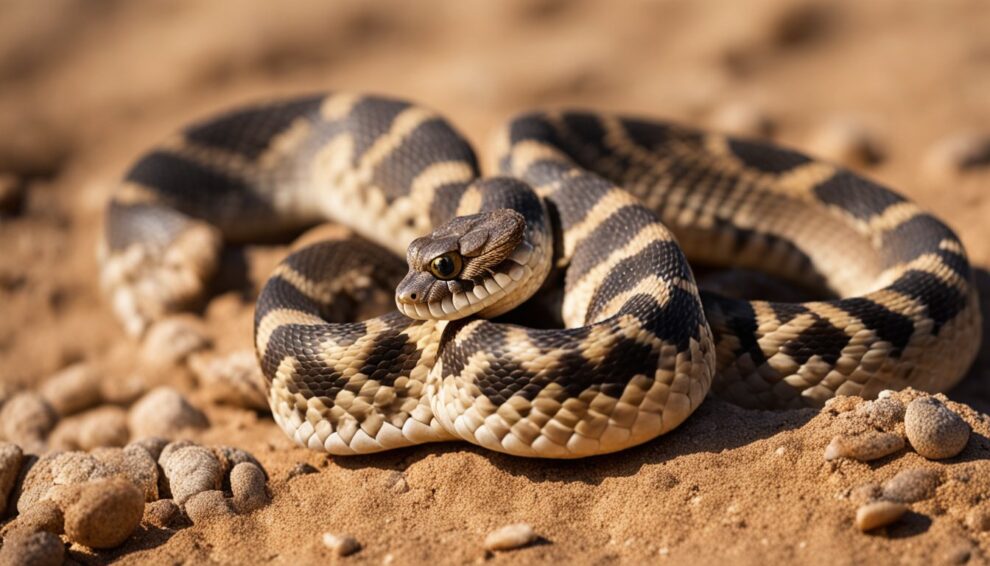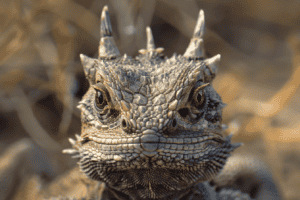In the vast expanse of the desert, where the sun bakes the sand into a sprawling canvas, the sidewinder rattlesnake performs its unique dance.
With a body designed for the harsh desert environment, this snake has perfected a peculiar mode of travel.
By throwing its body into looping, S-shaped curves and propelling itself sideways, the sidewinder moves across the hot sand.
This sidewinding movement is not only captivating to observe, but it is also an incredible adaptation for survival in one of Earth’s most unforgiving habitats.

Have you ever wondered how these creatures manage in temperatures that would send us seeking shade and a cool drink?
Well, their scaly skin reflects the desert sun, and just like you might hop across a hot beach, sidewinders limit their body contact with the sizzling ground.
They press only a fraction of their bodies onto the sand at any one time.
This nifty trick, along with burrowing into cooler layers of sand, keeps them from becoming overheated.
Sidewinder rattlesnakes are more than desert dancers; they are skilled hunters, equipped with a potent venom to subdue their prey.
Imagine an ambush predator so patient, it can wait hidden under the camouflage of sand for just the right moment to strike.
Their diet consists of small rodents, lizards, and birds, which they detect not only by sight but also by sensing vibrations through the ground.
It’s a tough life out there in the desert, but sidewinders have adapted in extraordinary ways to the environment they call home.
Can you picture the sidewinder’s sinuous movement across the sand, a dance of both beauty and purpose?
The Sidewinder’s Unique Motion
The sidewinder rattlesnake has developed a remarkable mode of travel to navigate the challenging desert environment.
This distinctive movement is not only a survival tactic but also an astonishing display of adaptation.
Adaptations for Desert Survival
In the scorching sands of the desert, the sidewinder rattlesnake exhibits exceptional characteristics that aid in its survival.
The sidewinder’s body is attuned to the desert climate, with scales that reflect rather than absorb heat, allowing it to endure the intense sun.
These snakes have a light-colored and patterned skin that melds into the sandy background, giving them an advantage over predators and prey.
Water conservation is another crucial adaptation; sidewinders can minimize water loss by reducing their activity during the hottest times of the day and by extracting moisture from their prey.
The Locomotion Technique
The sidewinder’s locomotion is a unique and efficient way to move across the hot desert sands.
By forming an S-shape with their bodies and thrusting their loops sideways, they create a set of parallel tracks, touching only two points on the ground at any given time.
This motion reduces their body’s contact with the hot sand and prevents overheating. Have you ever tried rubbing your hands together quickly?
Now imagine how hot that can get.
The sidewinder’s way of moving keeps them cool, much like if you were to touch something very swiftly with your fingertips rather than your whole hand.
The ability to move quickly and with agility also makes them formidable hunters, able to ambush prey with a sudden strike from their camouflaged position.
Habitat and Distribution

The Sidewinder Rattlesnake makes its home in some of the driest and sandiest places on earth.
Understanding where they live and the challenges they face is essential to appreciating these resilient reptiles.
Desert Ecosystem Challenges
Sidewinder Rattlesnakes are excellent navigators of the desert, an environment that’s harsh and unforgiving.
Scorching temperatures and scarce water supplies make survival a daily contest. Have you ever wondered how they manage this?
Their bodies have adapted to conserve moisture, and they retreat from the desert’s extreme heat by burrowing into cooler ground.
At night, when the desert cools down, they emerge to hunt.
Geographical Range
The geographical range of Sidewinder Rattlesnakes is quite specific; they are found in the southwestern United States and the northwestern part of Mexico.
Maps often show their presence in areas like the Mojave and Sonoran deserts.
You might think a snake would prefer somewhere lush and full of hiding spots, but sidewinders have mastered life on the dunes.
Can you picture them sidewinding across the shifting sands?
It’s a survival dance they’ve perfected to thrive in a world of extremes.
Diet and Hunting Strategies

Sidewinder rattlesnakes have developed unique methods to thrive in harsh desert environments.
They primarily feed on small desert creatures, and they have strategic hunting practices that set them apart from other snakes.
Hunting Tactics
When it comes to hunting, the sidewinder rattlesnake uses both ambush and active hunting strategies.
By burying itself in the sand, it can blend into its environment, remaining invisible to unsuspecting prey.
The sidewinder’s movement is also quite special; they move sideways in a distinctive “sidewinding” motion that allows them to swiftly glide across hot desert sand without overheating.
Their sidewinding movement leaves unique J-shaped tracks, often a telltale sign of their presence.
But how exactly does this rattlesnake catch its dinner? Patience is key — they can wait for hours, motionless, until a meal wanders by.
When prey does approach, sidewinders can strike with lightning speed, injecting venom with their fangs.
The venom is both a tool for subduing prey and beginning the digestion process.
Imagine being able to digest your snack before even taking the first bite — that’s the perk of being a sidewinder!
Prey and Predators
The diet of a sidewinder rattlesnake primarily includes small rodents, lizards, and occasionally birds.
Young sidewinders tend to eat cold-blooded creatures, while adults often prefer warm-blooded prey.
As for predators, sidewinders are not at the top of the food chain.
They have to watch out for birds of prey like hawks and eagles, which can swoop down and snatch them up without warning.
Coyotes and other larger mammals also pose a threat, using their keen sense of smell to track down these sneaky snakes.
It’s a tough world out there in the desert, but sidewinders have the moves and the moxie to make the most of their sandy home.
Can you imagine evading a hungry hawk by sidewinding away at the speed of lightning? That’s just a day in the life for these desert dwellers.
And here’s a cool fact: Sidewinder rattlesnakes actually grow new fangs throughout their lifetime!
If one breaks off, it’s only a matter of time before another sharp fang is ready to go. Isn’t that just snake-tastic?
Reproduction and Lifecycle

In the heart of the desert, Sidewinder rattlesnakes perform a unique and intriguing mating dance.
These cold-blooded reptiles have adapted remarkable strategies to reproduce and ensure the survival of their offspring in the arid surroundings they call home.
Mating Rituals
The mating season for Sidewinder rattlesnakes occurs in the spring and fall. During this time, males engage in a dance of dominance.
They coil and writhe against each other, competing for the attention of a nearby female. The winner gains the right to mate with her.
Courtship involves the male flicking his tongue to detect pheromones and following the scent of a receptive female.
Once he locates her, he begins a tactile display by rubbing his body along hers. If the female is willing, she will allow copulation to proceed.
Development of Offspring
After a successful mating, females carry the fertilized eggs internally.
Sidewinder rattlesnakes are ovoviviparous, meaning their eggs hatch within the mother, and she gives birth to live young.
Gestation lasts four to five months, culminating in the birth of 5 to 18 baby snakes.
Upon birth, the young sidewinders are entirely independent, coming into the world equipped with venom and the signature sideways locomotion.
They must quickly learn to navigate their sandy environment, find food, and avoid predators.
Remarkably, these miniature snakes will shed their skin within a week and grow rapidly in their initial months, a critical period for their survival.
Frequently Asked Questions

Sidewinder rattlesnakes have some pretty amazing ways to thrive in the desert. Did you know they move in a special way that keeps them cool on the hot sand?
Let’s explore some of the coolest facts about these snakes!
What special adaptations do sidewinder rattlesnakes have to live in the desert?
To live in the desert, sidewinder rattlesnakes have developed unique adaptations.
They have scales on their bellies that lift their bodies off the hot desert sand, and they can bury themselves to stay hidden and cool.
Their kidneys are super-efficient, letting them conserve water and survive in their dry environment.
How do sidewinder rattlesnakes perform their unique movement?
Sidewinder rattlesnakes travel by sideways looping motions, which allow them to move quickly over sandy terrain with minimal body contact with the ground.
This sideways “dance” helps them in two ways: they won’t sink into the sand, and less of their body is exposed to the ground’s searing heat.
What do sidewinder rattlesnakes eat, and how do they catch their prey?
These rattlesnakes eat small animals like lizards and rodents. They have an ambush strategy, hiding and waiting for prey to come close.
They strike lightning-fast, using their venom to subdue the meal. Have you ever seen a magician’s quick trick?
It’s almost like that, but in the wild!
How can you identify a sidewinder rattlesnake among other rattlesnake species?
You can spot a sidewinder rattlesnake by their horn-like scales above the eyes and the unique S-shaped trails they leave in the sand.
They’re smaller than most rattlesnakes, and their color often matches the desert sands—perfect for camouflage.
What role do sidewinder rattlesnakes play in their desert ecosystem?
Sidewinder rattlesnakes are both predator and prey in the desert.
They help control populations of the animals they eat, and they’re also food for birds of prey.
Their roles in the desert are all about balance, keeping the ecosystem running smoothly.
How do sidewinder rattlesnakes stay cool in the scorching desert temperatures?
These clever snakes stay cool by moving mostly at night when it’s not so hot. Can you imagine having a nighttime adventure every day?
They also use their unique sidewinding motion to reduce contact with the hot sand and seek shade during the heat of the day.









